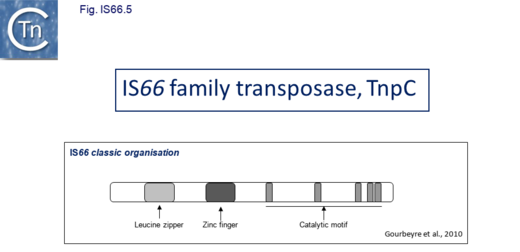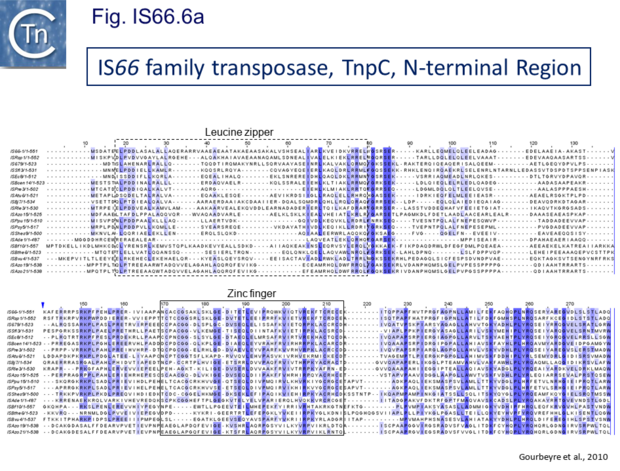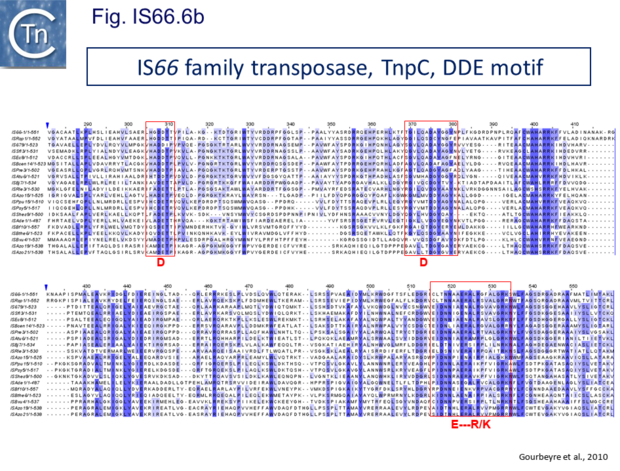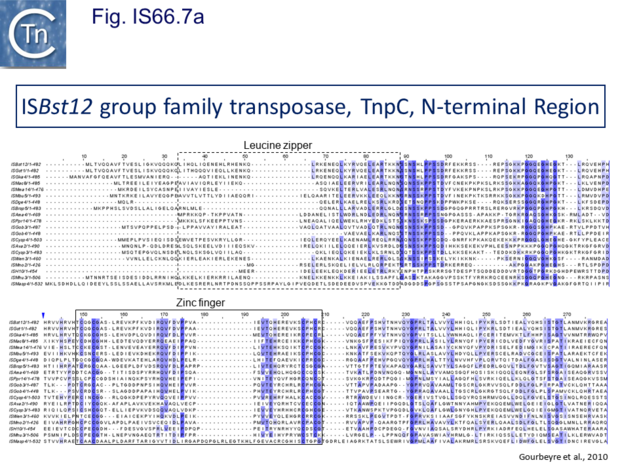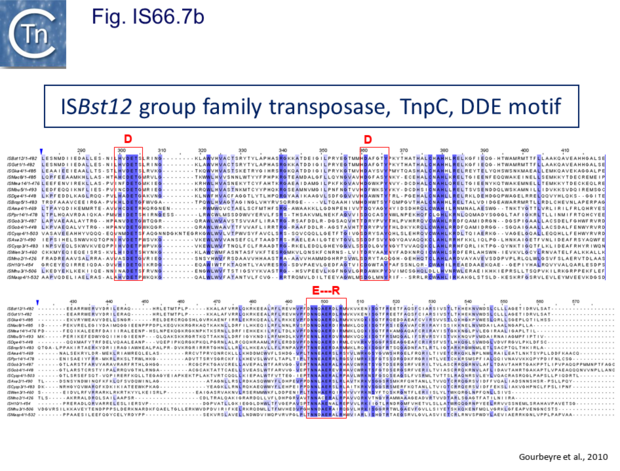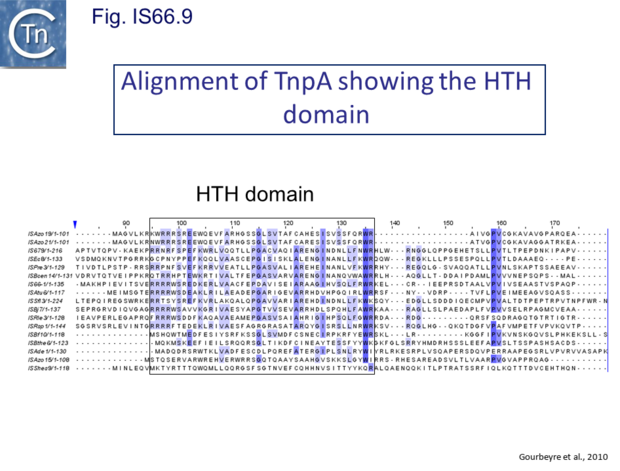Difference between revisions of "IS Families/IS66 family"
| Line 1: | Line 1: | ||
====General==== | ====General==== | ||
| − | IS''66'' was first identified in the Ti plasmid pTi66 of ''[[wikipedia:Agrobacterium_tumefaciens|Agrobacterium tumefaciens]]'' Sciaky<ref><nowiki><pubmed>6095299</pubmed></nowiki></ref><ref><nowiki><pubmed>6366736</pubmed></nowiki></ref> and, soon after in the symbiotic plasmid, pSym, of ''[[wikipedia:Sinorhizobium_fredii|Rhizobium fredii]]''<ref><nowiki><pubmed>24302303</pubmed></nowiki></ref>. The vast majority of IS''66'' members originate from the [[wikipedia:Proteobacteria|Proteobacteria]] with several from the [[wikipedia:Bacteroidetes|Bacteroidetes]]/[[wikipedia:Green_sulfur_bacteria|Chlorobi]] and the [[wikipedia:Firmicutes|Firmicutes]]. A second group of closely related ISs, widely spread among both bacteria and [[wikipedia:Archaea|archaea]] are thought to represent a sub-group within the IS''66'' family<ref | + | IS''66'' was first identified in the Ti plasmid pTi66 of ''[[wikipedia:Agrobacterium_tumefaciens|Agrobacterium tumefaciens]]'' Sciaky<ref><nowiki><pubmed>6095299</pubmed></nowiki></ref><ref><nowiki><pubmed>6366736</pubmed></nowiki></ref> and, soon after in the symbiotic plasmid, pSym, of ''[[wikipedia:Sinorhizobium_fredii|Rhizobium fredii]]''<ref><nowiki><pubmed>24302303</pubmed></nowiki></ref>. The vast majority of IS''66'' members originate from the [[wikipedia:Proteobacteria|Proteobacteria]] with several from the [[wikipedia:Bacteroidetes|Bacteroidetes]]/[[wikipedia:Green_sulfur_bacteria|Chlorobi]] and the [[wikipedia:Firmicutes|Firmicutes]]. A second group of closely related ISs, widely spread among both bacteria and [[wikipedia:Archaea|archaea]] are thought to represent a sub-group within the IS''66'' family<ref name=":0"><pubmed>20079432</pubmed></nowiki></ref>. These are relatively well distributed ([[:File:Fig IS66.1.png|Fig. IS66.1]]). The founder member, IS''Bst12'', originally isolated from ''[[wikipedia:Geobacillus_stearothermophilus|Bacillus stearothermophilus]]'', was described as a novel family<ref name=":1"><pubmed>10974105</pubmed></nowiki></ref>, but identification of many additional examples suggests that the IS''Bst12'' and IS''66'' groups should be considered a single family ([[:File:Fig IS66.2.png|Fig. IS66.2]]). Several examples of IS derivatives with passenger genes have been identified ([[:File:Fig IS66.3.png|Fig. IS66.3]]; [[IS Families/IS66 family#A list of representative IS66 family members and the ISBst12 group|Table IS66.1]]). One important example is a potential tIS in which IRL is located downstream from an MCR-3 ([[wikipedia:Colistin|colistin resistance gene]]) <ref><nowiki><pubmed>29712655</pubmed></nowiki></ref>. Members of the IS''Bst12'' group are found in [[wikipedia:Actinobacteria|Actinobacteria]], [[wikipedia:Cyanobacteria|Cyanobacteria]], ''[[wikipedia:Deinococcus|Deinococcus]]''/''[[wikipedia:Thermus|Thermus]]'', [[wikipedia:Firmicutes|Firmicutes]], and [[wikipedia:Planctomycetes|Planctomycetes]] as well as in [[wikipedia:Proteobacteria|Proteobacteria]]. They are also found in the https://en.wikipedia.org/wiki/Euryarchaeota phylum of [[wikipedia:Archaea|archaea]] (but have not yet been identified in the [[wikipedia:Crenarchaeota|Crenarchaeota]]). |
<br /> | <br /> | ||
[[File:Fig IS66.1.png|center|thumb|550x550px|'''Fig IS66.1.''' Distance tree computed by neighbor-joining, using the JTT matrix-based<ref><nowiki><pubmed>1633570</pubmed></nowiki></ref> with gamma-distribution and bootstrap of 500 replicates. The results are visualized with [https://code.google.com/archive/p/treeviewx/ TreeView]<ref><nowiki><pubmed>18792942</pubmed></nowiki></ref>. Pink boxes indicate Firmicutes, blue boxes indicate Bacteroidetes/Chlorobi, and green boxes with white characters indicate Archaeal hosts. |alt=]] | [[File:Fig IS66.1.png|center|thumb|550x550px|'''Fig IS66.1.''' Distance tree computed by neighbor-joining, using the JTT matrix-based<ref><nowiki><pubmed>1633570</pubmed></nowiki></ref> with gamma-distribution and bootstrap of 500 replicates. The results are visualized with [https://code.google.com/archive/p/treeviewx/ TreeView]<ref><nowiki><pubmed>18792942</pubmed></nowiki></ref>. Pink boxes indicate Firmicutes, blue boxes indicate Bacteroidetes/Chlorobi, and green boxes with white characters indicate Archaeal hosts. |alt=]] | ||
| Line 10: | Line 10: | ||
====Genome Impact==== | ====Genome Impact==== | ||
| − | Members of this family are involved in insertional gene inactivation (e.g. inactivation of the [https://jb.asm.org/content/191/9/2973 ''liaFSR'' operon] leading to hypersensitivity to [[wikipedia:Daptomycin|daptomycin]]<ref><nowiki><pubmed>27353469</pubmed></nowiki></ref>; loss of loss of S-layer-gene expression in ''[[wikipedia:Geobacillus_stearothermophilus|Bacillus stearothermophilus]] | + | Members of this family are involved in insertional gene inactivation (e.g. inactivation of the [https://jb.asm.org/content/191/9/2973 ''liaFSR'' operon] leading to hypersensitivity to [[wikipedia:Daptomycin|daptomycin]]<ref><nowiki><pubmed>27353469</pubmed></nowiki></ref>; loss of loss of S-layer-gene expression in ''[[wikipedia:Geobacillus_stearothermophilus|Bacillus stearothermophilus]] <ref name=":1" />''; gene disruption in the cyanobacterium ''[https://microbewiki.kenyon.edu/index.php/Fremyella_diplosiphon Fremyella duplosiphon]'' involved in regulation of [[wikipedia:Phycoerythrin|phycoerythrin]] synthesis<ref><nowiki><pubmed>21888899</pubmed></nowiki></ref> and in the ''gnaA'' (encoding [[wikipedia:UDP-N-acetylglucosamine_6-dehydrogenase|UDP-N-acetylglucosamine C-6 dehydrogenase]]) of ''[[wikipedia:Acinetobacter_baumannii|Acinetobacter baumannii]]'' leading to changes in the antibacterial resistance profile<ref><nowiki><pubmed>31358579</pubmed></nowiki></ref>). |
It has also been shown (using RACE) that IS''66'' insertion can create hybrid promoters<ref><nowiki><pubmed>29374029</pubmed></nowiki></ref>. | It has also been shown (using RACE) that IS''66'' insertion can create hybrid promoters<ref><nowiki><pubmed>29374029</pubmed></nowiki></ref>. | ||
| Line 16: | Line 16: | ||
====Organization==== | ====Organization==== | ||
[[File:Fig IS66.4.png|left|thumb|450x450px|'''Fig IS66.4.''' The left ('''IRL''') and right (IRR) inverted terminal repeats are shown in the [https://weblogo.berkeley.edu/ WebLogo format]. They are defined by the direction of transcription of the transposase gene. IRL, by definition, is located on the 5’ side of the transposase orf. ]] | [[File:Fig IS66.4.png|left|thumb|450x450px|'''Fig IS66.4.''' The left ('''IRL''') and right (IRR) inverted terminal repeats are shown in the [https://weblogo.berkeley.edu/ WebLogo format]. They are defined by the direction of transcription of the transposase gene. IRL, by definition, is located on the 5’ side of the transposase orf. ]] | ||
| − | The IS''66'' reference copy from a plasmid of the enteropathogenic ''[[wikipedia:Escherichia_coli|Escherichia coli]]'' B171, IS''679''<ref | + | The IS''66'' reference copy from a plasmid of the enteropathogenic ''[[wikipedia:Escherichia_coli|Escherichia coli]]'' B171, IS''679''<ref name=":2"><pubmed>11418571</pubmed></nowiki></ref> is defined by three ''orfs'' ([[:File:Fig IS66.3.png|Fig. IS66.3]]): ''tnpA'', ''tnpB'' and ''tnp''C and relatively well conserved terminal IR of about 20-30 bp flanked by an 8 bp DR at their insertion sites ([[:File:Fig IS66.4.png|Fig. IS66.4]]). Orf ''tnp''C ([[:File:Fig IS66.5.png|Fig. IS66.5]]) is 1572 bp and its predicted product includes an N-terminal region with potential leucine zipper and zinc finger motifs ([[:File:Fig IS66.5.png|Fig. IS66.5]]; [[:File:Fig IS66.6A.png|Fig. IS66.6a]]; [[:File:Fig IS66.7A.png|Fig. IS66.7a]]) and a typical DDE motif ([[:File:Fig IS66.5.png|Fig. IS66.5]]; [[:File:Fig IS66.6B.png|Fig. IS66.6b]]; [[:File:Fig IS66.7B.png|Fig. IS66.7b]]; outlined in [[:File:IS6.8.png|Fig. IS66.8]]). It also carries an insertion domain between the second D and the E of the DDE motif (e.g.IS''679,'' IS''Psy5 and'' IS''Mac8'')<ref><nowiki><pubmed>20067338</pubmed></nowiki></ref> (see [[:File:1.8.3.png|Fig. 1.8.3]]) ([[General Information/Major Groups are Defined by the Type of Transposase They Use#Transposases examined by secondary structure prediction programs|Table Transposases examined by secondary structure prediction programs]]). |
| − | The role of the products of ''tnpA'' (651 bp) and ''tnpB'' (345 bp) is less clear. TnpA carries a potential [[wikipedia:Helix-turn-helix|HTH motif]] (([[:File:Fig IS66.9.png|Fig. IS66.9]]) while TnpB shows no marked potential secondary structure motifs. Mutation of each ''orf'' separately (by introduction of an ''in-frame'' deletion) reduced transposition by at least two orders of magnitude <ref | + | The role of the products of ''tnpA'' (651 bp) and ''tnpB'' (345 bp) is less clear. TnpA carries a potential [[wikipedia:Helix-turn-helix|HTH motif]] (([[:File:Fig IS66.9.png|Fig. IS66.9]]) while TnpB shows no marked potential secondary structure motifs. Mutation of each ''orf'' separately (by introduction of an ''in-frame'' deletion) reduced transposition by at least two orders of magnitude <ref name=":2" />. The three frames are disposed in a pattern suggesting translational coupling: ''tnpB'' is in general in translational reading frame -1 compared to ''tnpA'' and in most cases the termination codon of ''tnpA'' and the initiation codon of ''tnpB'' overlap (ATGA). An initiation codon for ''tnpC'' occurs slightly downstream separated from ''tnpB'' by about 20 bp. |
However, rather surprisingly, in the light of a requirement for all three ''orfs'' for transposition of the canonical IS''66'' family member IS''679'', members of the IS''Bst12'' group are devoid of ''tnpA'' and ''tnpB'' and carry only the ''tnpC'' reading frame. Although both IS''Bst12'' and IS''66'' members contain IRs which start with 5’GTAA3’, they are clearly distinguishable due to a single conserved A at bp 11 In IS''Bst12'' which is not conserved in IS''66'' ([[:File:Fig IS66.1.png|Fig. IS66.1]]; [[:File:Fig IS66.4.png|Fig. IS66.4]]). | However, rather surprisingly, in the light of a requirement for all three ''orfs'' for transposition of the canonical IS''66'' family member IS''679'', members of the IS''Bst12'' group are devoid of ''tnpA'' and ''tnpB'' and carry only the ''tnpC'' reading frame. Although both IS''Bst12'' and IS''66'' members contain IRs which start with 5’GTAA3’, they are clearly distinguishable due to a single conserved A at bp 11 In IS''Bst12'' which is not conserved in IS''66'' ([[:File:Fig IS66.1.png|Fig. IS66.1]]; [[:File:Fig IS66.4.png|Fig. IS66.4]]). | ||
| − | IS''66'' members can be grouped into three classes based on their organization: those including all three ''orfs'', A, B and C transcribed in the same direction; those with additional passenger genes invariably present downstream of ''orf''C and transcribed in the same direction; and those which lack ''orf''A but retain both ''orfs'' B and C ([[:File:Fig IS66.1.png|Fig. IS66.1]]; [[:File:Fig IS66.3.png|Fig. IS66.3]]). Each of these organizations includes members with multiple copies, implying that they are active in transposition. In addition to the DDE catalytic domain ([[:File:Fig IS66.5.png|Fig. IS66.5]]; [[:File:Fig IS66.6B.png|Fig. IS66.6b]]; [[:File:Fig IS66.7B.png|Fig. IS66.7b]])<ref | + | IS''66'' members can be grouped into three classes based on their organization: those including all three ''orfs'', A, B and C transcribed in the same direction; those with additional passenger genes invariably present downstream of ''orf''C and transcribed in the same direction; and those which lack ''orf''A but retain both ''orfs'' B and C ([[:File:Fig IS66.1.png|Fig. IS66.1]]; [[:File:Fig IS66.3.png|Fig. IS66.3]]). Each of these organizations includes members with multiple copies, implying that they are active in transposition. In addition to the DDE catalytic domain ([[:File:Fig IS66.5.png|Fig. IS66.5]]; [[:File:Fig IS66.6B.png|Fig. IS66.6b]]; [[:File:Fig IS66.7B.png|Fig. IS66.7b]])<ref name=":0" />, TnpC also exhibits a highly conserved CwAH-rR motif downstream of the second D residue, a relatively conserved CX2(C)X33CX2C motif characteristic of a [[wikipedia:Zinc_finger|zinc finger]] (ZF) further upstream and a leucine-rich region which might form a [[wikipedia:Leucine_zipper|leucine zipper]] (LZ) necessary in multimerisation of other Tpases <ref><nowiki><pubmed>9761671</pubmed></nowiki></ref>, at the N-terminus ([[:File:Fig IS66.5.png|Fig. IS66.5]]; [[:File:Fig IS66.6A.png|Fig. IS66.6a]]; [[:File:Fig IS66.7A.png|Fig. IS66.7a]]). |
Revision as of 18:30, 22 June 2020
Contents
General
IS66 was first identified in the Ti plasmid pTi66 of Agrobacterium tumefaciens Sciaky[1][2] and, soon after in the symbiotic plasmid, pSym, of Rhizobium fredii[3]. The vast majority of IS66 members originate from the Proteobacteria with several from the Bacteroidetes/Chlorobi and the Firmicutes. A second group of closely related ISs, widely spread among both bacteria and archaea are thought to represent a sub-group within the IS66 family[4]. These are relatively well distributed (Fig. IS66.1). The founder member, ISBst12, originally isolated from Bacillus stearothermophilus, was described as a novel family[5], but identification of many additional examples suggests that the ISBst12 and IS66 groups should be considered a single family (Fig. IS66.2). Several examples of IS derivatives with passenger genes have been identified (Fig. IS66.3; Table IS66.1). One important example is a potential tIS in which IRL is located downstream from an MCR-3 (colistin resistance gene) [6]. Members of the ISBst12 group are found in Actinobacteria, Cyanobacteria, Deinococcus/Thermus, Firmicutes, and Planctomycetes as well as in Proteobacteria. They are also found in the https://en.wikipedia.org/wiki/Euryarchaeota phylum of archaea (but have not yet been identified in the Crenarchaeota).
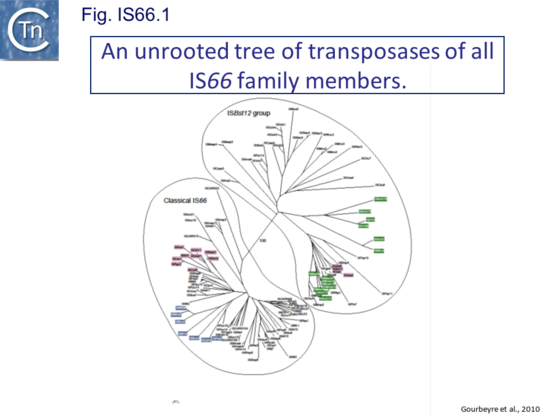
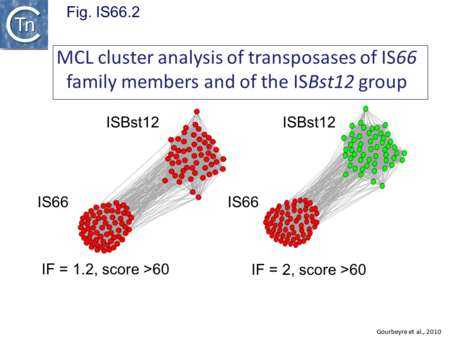
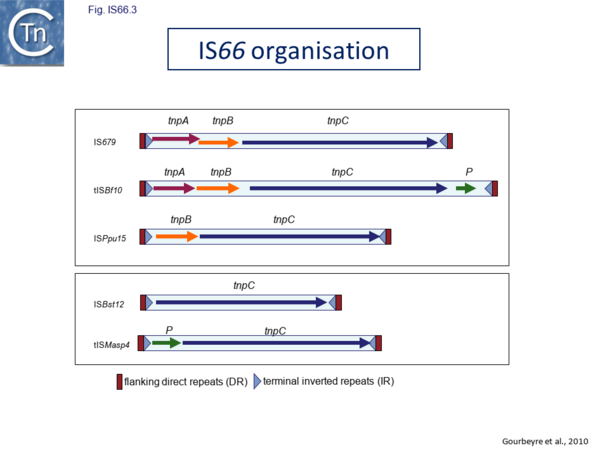
Genome Impact
Members of this family are involved in insertional gene inactivation (e.g. inactivation of the liaFSR operon leading to hypersensitivity to daptomycin[9]; loss of loss of S-layer-gene expression in Bacillus stearothermophilus [5]; gene disruption in the cyanobacterium Fremyella duplosiphon involved in regulation of phycoerythrin synthesis[10] and in the gnaA (encoding UDP-N-acetylglucosamine C-6 dehydrogenase) of Acinetobacter baumannii leading to changes in the antibacterial resistance profile[11]).
It has also been shown (using RACE) that IS66 insertion can create hybrid promoters[12].
Organization
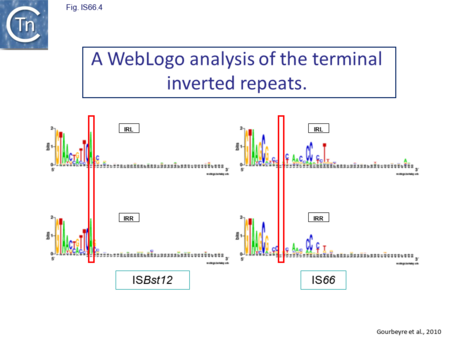
The IS66 reference copy from a plasmid of the enteropathogenic Escherichia coli B171, IS679[13] is defined by three orfs (Fig. IS66.3): tnpA, tnpB and tnpC and relatively well conserved terminal IR of about 20-30 bp flanked by an 8 bp DR at their insertion sites (Fig. IS66.4). Orf tnpC (Fig. IS66.5) is 1572 bp and its predicted product includes an N-terminal region with potential leucine zipper and zinc finger motifs (Fig. IS66.5; Fig. IS66.6a; Fig. IS66.7a) and a typical DDE motif (Fig. IS66.5; Fig. IS66.6b; Fig. IS66.7b; outlined in Fig. IS66.8). It also carries an insertion domain between the second D and the E of the DDE motif (e.g.IS679, ISPsy5 and ISMac8)[14] (see Fig. 1.8.3) (Table Transposases examined by secondary structure prediction programs).
The role of the products of tnpA (651 bp) and tnpB (345 bp) is less clear. TnpA carries a potential HTH motif ((Fig. IS66.9) while TnpB shows no marked potential secondary structure motifs. Mutation of each orf separately (by introduction of an in-frame deletion) reduced transposition by at least two orders of magnitude [13]. The three frames are disposed in a pattern suggesting translational coupling: tnpB is in general in translational reading frame -1 compared to tnpA and in most cases the termination codon of tnpA and the initiation codon of tnpB overlap (ATGA). An initiation codon for tnpC occurs slightly downstream separated from tnpB by about 20 bp.
However, rather surprisingly, in the light of a requirement for all three orfs for transposition of the canonical IS66 family member IS679, members of the ISBst12 group are devoid of tnpA and tnpB and carry only the tnpC reading frame. Although both ISBst12 and IS66 members contain IRs which start with 5’GTAA3’, they are clearly distinguishable due to a single conserved A at bp 11 In ISBst12 which is not conserved in IS66 (Fig. IS66.1; Fig. IS66.4).
IS66 members can be grouped into three classes based on their organization: those including all three orfs, A, B and C transcribed in the same direction; those with additional passenger genes invariably present downstream of orfC and transcribed in the same direction; and those which lack orfA but retain both orfs B and C (Fig. IS66.1; Fig. IS66.3). Each of these organizations includes members with multiple copies, implying that they are active in transposition. In addition to the DDE catalytic domain (Fig. IS66.5; Fig. IS66.6b; Fig. IS66.7b)[4], TnpC also exhibits a highly conserved CwAH-rR motif downstream of the second D residue, a relatively conserved CX2(C)X33CX2C motif characteristic of a zinc finger (ZF) further upstream and a leucine-rich region which might form a leucine zipper (LZ) necessary in multimerisation of other Tpases [15], at the N-terminus (Fig. IS66.5; Fig. IS66.6a; Fig. IS66.7a).
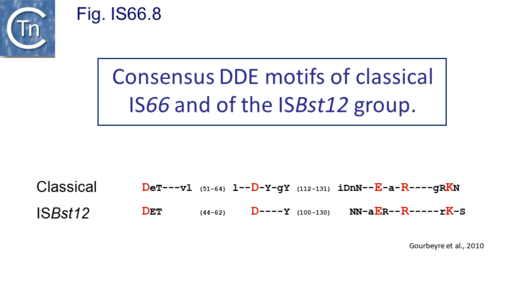
A list of representative IS66 family members and the ISBst12 group
| Table IS66.1. A list of representative IS66 family members and the ISBst12 group. The table summarises from left to right: the IS name; group defined in the MCL analysis; accession number; host from which it was identified; kingdom (archaea, A, or bacteria, B); phylum; organisation (org) A,B,C,P show the presence of TnpA, TnpB, TnpC and Passenger genes respectively; length of the IS in base pairs (bp); length of the terminal Inverted Repeats (IR); length of flanking Direct Repeats (DR); number of examples identified in the host genome. | ||||||||||
| IS Name | Group | Accession number | Host | A/B | G+/G- | Org. | L (bp) | IR (bp) | DR (bp) | N° |
|---|---|---|---|---|---|---|---|---|---|---|
| IS66-1 | — | AF242881 | Agrobacterium tumefaciens | B | G- | ABC | 2556 | 18/20 | 8 | 2 |
| IS679 | — | NC_002142 | Escherichia coli | B | G- | ABC | 2704 | 17/25 | 8 | 6 |
| ISAde1 | — | NC_011891 | Anaeromyxobacter dehalogenans 2CP-1 | B | G- | ABC | 2957 | 20/27 | 8 | 2 |
| ISAtu6 | — | NC_010929 | Agrobacterium tumefaciens | B | G- | ABCP | 2798 | 23/24 | 8 | 3 |
| ISAzo15 | — | NC_006513 | Azoarcus sp. EbN1 or Aromatoleum aromaticum EbN1 | B | G- | ABC | 2441 | 20/21 | 8 | 4 |
| ISAzo19 | — | NC_006513 | Azoarcus sp. EbN1 or Aromatoleum aromaticum EbN1 | B | G- | ABC | 2423 | 23/26 | 8 | 3 |
| ISAzo21 | — | NC_006513 | Azoarcus sp. EbN1 or Aromatoleum aromaticum EbN1 | B | G- | ABC | 2423 | 23/26 | 8 | 2 |
| ISBcen14 | — | NC_011001 | Burkholderia cenocepacia J2315 | B | G- | ABC | 2516 | 18/22 | 8 | 4 |
| ISBf10 | — | NC_006347 | Bacteroides fragilis YCH46 | B | G- | ABCP | 2939 | 20/21 | 8 | 4 |
| ISBj7 | — | NC_004463 | Bradyrhizobium japonicum USDA 110 | B | G- | ABC | 2865 | 40/50 | 8 | 2 |
| ISBthe6 | — | NC_004663 | Bacteroides thetaiotaomicron | B | G- | ABC | 2544 | 24 | 8 | 2 |
| ISBvu4 | — | NC_009614 | Bacteroides vulgatus ATCC 8482 | B | G- | BC | 2371 | 30/32 | 8 | 5 |
| ISEc8 | — | NC_004431 | Escherichia coli CFT073 | B | G- | ABC | 2442 | 18/22 | 8 | 7 |
| ISPpu15 | — | NC_002947 | Pseudomonas putida KT2440 | B | G- | BC | 2041 | 22/28 | 8 | 4 |
| ISPre3 | — | NC_004444 | Pseudomonas resinovorans | B | G- | ABCP | 2957 | 17/24 | 8 | 2 |
| ISPsy5 | — | AE016853 | Pseudomonas syringae pv. tomato str. DC3000 | B | G- | BC | 2059 | 21/28 | 8 | 33 |
| ISRle3 | — | NC_008382 | Rhizobium leguminosarum bv. viciae 3841 | B | G- | ABC | 2500 | 14/15 | 8 | 2 |
| ISRsp1 | — | U00090 | Rhizobium sp. NGR234 | B | G- | ABCP | 3481 | 17/22 | 8 | 2 |
| ISSfl3 | — | AL391753 | Shigella flexneri | B | G- | ABC | 2729 | 11 | 0 | 2 |
| ISShes9 | — | NC_008750 | Shewanella sp. W3-18-1 | B | G- | ABC | 2370 | 18/24 | 8 | 3 |
| ISAma4 | ISBst12 | NC_011138 | Alteromonas macleodii 'Deep ecotype' | B | G- | C | 1529 | 28/29 | 9 | 3 |
| ISAva2 | ISBst12 | NC_007410 | Anabaena variabilis ATCC 29413 | B | G- | C | 1547 | 14 | 8 | 9 |
| ISBrsp5 | ISBst12 | NC_009445 | Bradyrhizobium sp. ORS278 | B | G- | C | 1541 | 18/19 | 8 | 2 |
| ISBst12 | ISBst12 | AF162268 | Bacillus stearothermophilus | B | G+ | C | 1612 | 15/16 | 8 | 15 |
| ISCysp3 | ISBst12 | NZ_AAXW00000000 | Cyanothece sp. CCY 0110 | B | G- | C | 1522 | 14 | 8 | 18 |
| ISCysp4 | ISBst12 | NC_011884 | Cyanothece sp. PCC 7425 | B | G- | C | 1585 | 14/17 | 8 | 12 |
| ISDge4 | ISBst12 | NC_008025 | Deinococcus geothermalis DSM 11300 | B | G+ | C | 1453 | 18/25 | 8 | 6 |
| ISGka4 | ISBst12 | NC_006509 | Geobacillus kaustophilus HTA426 | B | G+ | C | 1635 | 21/24 | 8 | 3 |
| ISGob3 | ISBst12 | NZ_ABGO00000000 | Gemmata obscuriglobus UQM 2246 | B | G- | C | 1597 | 11/12 | 8 | 8 |
| ISGob4 | ISBst12 | NZ_ABGO00000000 | Gemmata obscuriglobus UQM 2246 | B | G- | C | 1576 | 14/15 | 8 | 6 |
| ISGst1 | ISBst12 | NC_010420 | Geobacillus stearothermophilus | B | G+ | C | 1613 | 18/26 | 8 | 3 |
| ISH10 | ISBst12 | NC_002607 | Halobacterium sp. NRC-1 | A | — | C | 1584 | 16/18 | 8 | 5 |
| ISMac8 | ISBst12 | NC_003552 | Methanosarcina acetivorans C2A | A | — | C | 1603 | 13/15 | 8 | 3 |
| ISMasp4 | ISBst12 | NC_008576 | Magnetococcus sp. MC-1 | B | G- | PC | 1969 | 19 | 8 | 7 |
| ISMbu5 | ISBst12 | NC_007955 | Methanococcoides burtonii DSM 6242 | A | — | C | 1696 | 18/19 | 8/0 | 9 |
| ISMhu3 | ISBst12 | NC_007796 | Methanospirillum hungatei JF-1 | A | — | PC | 1727 | 9/12 | 0 | 2 |
| ISMma14 | ISBst12 | NC_003901 | Methanosarcina mazei Go1 | A | — | C | 1529 | 22/30 | 8 | 9 |
| ISMno2 | ISBst12 | NC_011894 | Methylobacterium nodulans ORS 2060 | B | G- | C | 1419 | 21/27 | 8 | 8 |
| ISPpr14 | ISBst12 | NC_006371 | Photobacterium profundum SS9 | B | G- | C | 1568 | 19/27 | 8/9 | 9 |
| ISWen3 | ISBst12 | NZ_AAGB00000000 | Wolbachia endosymbiont of Drosophila ananassae | B | G- | C | 1482 | 18/20 | 8-0 | 30 |
Mechanism and Insertion Specificity
Nothing is known about the transposition mechanism of this group of IS and they exhibit no substantial target sequence specificity.
Bibliography
- ↑ <pubmed>6095299</pubmed>
- ↑ <pubmed>6366736</pubmed>
- ↑ <pubmed>24302303</pubmed>
- ↑ 4.0 4.1 Gourbeyre E, Siguier P, Chandler M . Route 66: investigations into the organisation and distribution of the IS66 family of prokaryotic insertion sequences. - Res Microbiol: 2010 Mar, 161(2);136-43 [PubMed:20079432] [DOI] </nowiki>
- ↑ 5.0 5.1 Egelseer EM, Idris R, Jarosch M, Danhorn T, Sleytr UB, Sára M . ISBst12, a novel type of insertion-sequence element causing loss of S-layer-gene expression in Bacillus stearothermophilus ATCC 12980. - Microbiology (Reading): 2000 Sep, 146 ( Pt 9);2175-2183 [PubMed:10974105] [DOI] </nowiki>
- ↑ <pubmed>29712655</pubmed>
- ↑ <pubmed>1633570</pubmed>
- ↑ <pubmed>18792942</pubmed>
- ↑ <pubmed>27353469</pubmed>
- ↑ <pubmed>21888899</pubmed>
- ↑ <pubmed>31358579</pubmed>
- ↑ <pubmed>29374029</pubmed>
- ↑ 13.0 13.1 Han CG, Shiga Y, Tobe T, Sasakawa C, Ohtsubo E . Structural and functional characterization of IS679 and IS66-family elements. - J Bacteriol: 2001 Jul, 183(14);4296-304 [PubMed:11418571] [DOI] </nowiki>
- ↑ <pubmed>20067338</pubmed>
- ↑ <pubmed>9761671</pubmed>
